 |
||
|
||
| ||
Part 3. Game benchmarksContents
Testbed configuration
VSync disabled. Test results: performance comparisonWe used the following benchmarks:
Test results are available in Excel tables in RAR and ZIP archives Those of you who are into 3D graphics will understand the charts themselves. And newbies and those who have just begun choosing graphics cards can read our comments. First of all, you should browse our brief references dedicated to modern graphics card series and underlying GPUs. Note clock rates, shader support, and pipeline architecture. You should understand that 8800 series made the "pipeline" term obsolete. Now there are stream processors handling games' shader instructions, texture processors handling pixels (texturing, filtering). In other words, everything's separated. And only after texture operations are complete data is written to memory buffer, like always. Before it has been like that: take a triangle, process it with a shader instruction set, texture it, filter it, and send it along. This has come to an end. Now drivers together with special thread processors decide which stream processor will do what and when. The same can be said about texture processors. The R600 family operates in a similar way. Reference of ATI RADEON X1300-1600-1800-1900 seriesReference of NVIDIA GeForce 7300-7600-7800-7900-8800 seriesSecondly, you can browse our 3D graphics section for the basics of 3D and some new product references. There are only two companies that release graphics processing units: ATI (recently merged with AMD and obtained its name) and NVIDIA. Therefore all information is generally separated in two respective parts. You can also read our monthly 3Digest, which sums up all graphics card performance charts. Thirdly, we'll see how the examined graphics card performs in benchmarks. We conducted two test sets: a complete one under Windows XP (since today it's the most popular gaming OS) and a brief one under Windows Vista (today this OS is still raw, so you should use it just to examine DirectX 10). Now some words about overclocking. While the drivers prevent 2900 XT from overclocking without an 8-pin power connection, there's an utility from AMD that enables to bypass this. Thus we have also obtained results at 850/2000 MHz clock rates. Remember that today many games are bottlenecked by CPUs and systems in general, so even the most powerful graphics card might not be able to show its potential in AA 4x and AF 16x modes. Therefore, examining previous top-performing products, we have added a new HQ (High Quality) mode, which stands for:
Above are screenshots that demonstrate the HQ quality. Note that R600 has AF on the level of High Quality AF produced by the X1xxx series and it's nearly identical to AF of NVIDIA GeForce 8800 series. So, there's no sense in making some dedicated screenshots for it. And another matter: we will compare HD 2900 XT only with GeForce 8800 GTS, according to the market positioning of these products. Testing under Windows XPFarCry, Research (No HDR)Test results: FarCry Research (No HDR)
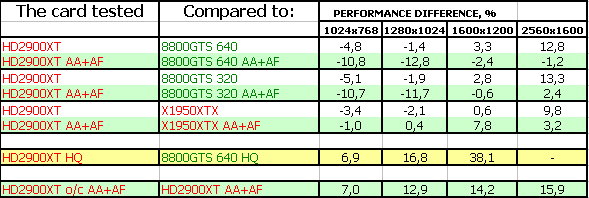
Since without the HQ mode this game is only bottlenecked by CPU, we'll only compare the HQ mode in which 2900 XT demonstrated some very good results. Especially at 1600x1200 providing good gameplay. Overclocking boosted performance only by 15%. Perhaps, CPU bottlenecked that. Besides, shader unit clock rate might have increased in the same proportion as well. (We remember how abruptly the performance of 8800 series reacted to a fast increase of shader unit clock rate during overclocking). FarCry, Research (HDR)Test results: FarCry Research (HDR)
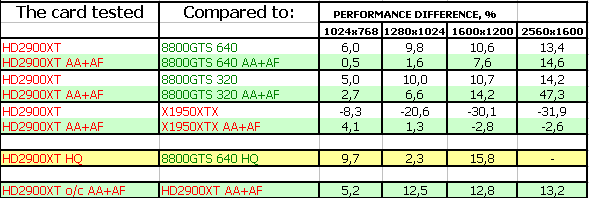
The load increased in this test, so even without HQ mode we witness the superiority of R600. Though, along with a strange and significant defeat of X1950 XTX. Perhaps, we should blame drivers. F.E.A.R.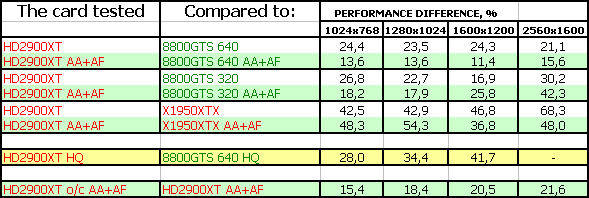
In this game that puts some very heavy load on graphics cards R600 is clearly the winner. But why its performance drops in AA+AF mode? It would seem that 512-bit bus should have provided AA nearly "free of charge". AMD officially said that was because of raw drivers. Another reason was the disbalance between the power of shader unit and that of texture unit that ATI is still implementing. 16 texture processors is just not enough for such a his large amount of shader processors. Splinter Cell Chaos Theory (No HDR)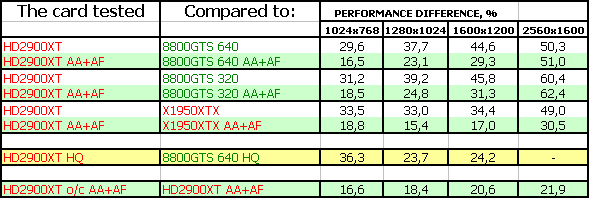
A similar picture. But since this game puts even heavier load on shaders, the novelty showed definite advantage even with AA+AF. Splinter Cell Chaos Theory (HDR)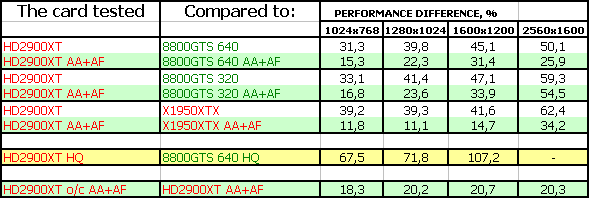
The same picture again. In the HQ mode the new product outperforms 8800 GTS nearly twofold! Call Of Juarez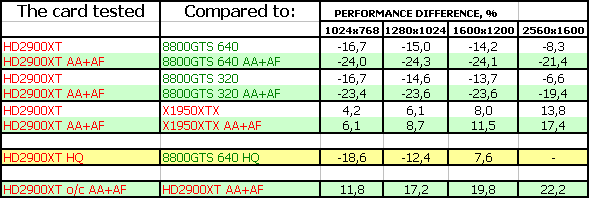
In this game, that had already become a problem for NVIDIA and its 8800 series, R600 stumbled upon some issues as well. First of all, it lost completely. But it's early to judge, because there are some serious quality problems related to shadows and artefacts. Let's wait until they fix these in new drivers. Company Of Heroes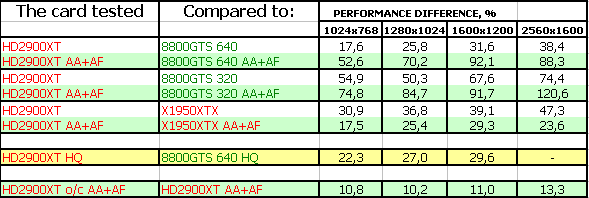
And this test is just the opposite. In it R600 outperforms its rival the most! But overclocking boosted performance by just 11%. Serious Sam II (No HDR)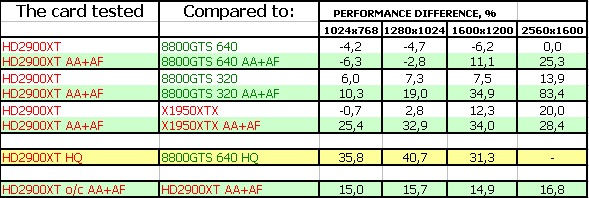
And still the reason of 2900 XT demostrating lower performance with AA+AF must be the drivers. So, there might be a cure. On this example we can see that AA+AF load gives a greater advantage to R600. Serious Sam II (HDR)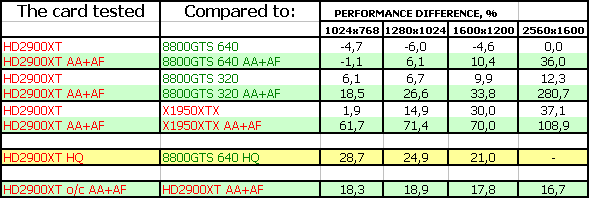
A similar picture. Though we remember this game is very critical to performance of ROPs and texture processors. Prey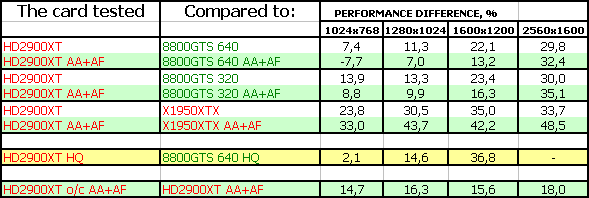
And again the new graphics card lost some performance with AA+AF. Drivers again? Or still an architectural disbalance? I guess we'll get the answer after new drivers are released. 3DMark05: MARKS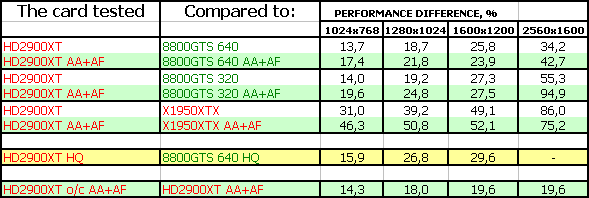
3DMark06: SHADER 2.0 MARKSTest results: 3DMark06 SM2.0 MARKS
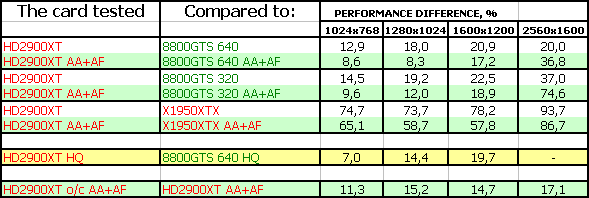
3DMark06: SHADER 3.0 MARKSTest results: 3DMark06 SM3.0 MARKS
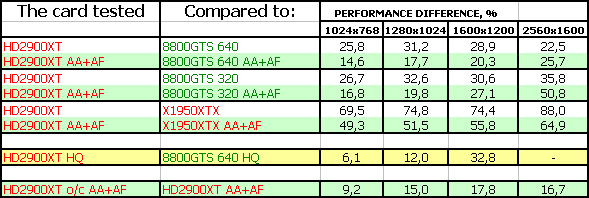
The new product performs naturally good in synthetic tests. It's not a secret that performance of any new graphics card is honed in benchmarks like 3DMark nearly in the first place. Testing under Windows VistaThere are no test results for Prey (due to OpenGL issues) and Call Of Juarez (game installation issues). FarCry, Research (No HDR)Test results: FarCry Research (No HDR)

This is similar to XP. And again the novelty loses performance with AA+AF. FarCry, Research (HDR)Test results: FarCry Research (HDR)

And this is just the opposite. It seems logical: the 512-bit bus provides greater advantage as resolution increases. In other words, a mystery. Waiting for newer drivers. F.E.A.R.
It's like a sine: one test nearly fails with AA+AF, the next is vice versa, the third fails it again. :) Splinter Cell Chaos Theory (No HDR)
And again some performance loss with AA+AF. But generally ATI wins. Splinter Cell Chaos Theory (HDR)
Surprisingly, here everything's as it should be... Call Of Juarez DX10 Benchmark
We'll provide some screenshots, so you are able to see the beauty and importance of this benchmark.
Since at the moment of testing GeForce 8800 GTS had AA issues in this test, we excluded such modes from our comparison. Anyway, it's clear the 2900 XT wins. Please remember, this is a DX10 application! Company Of Heroes
R600 outperforms its rival all right. Serious Sam II (No HDR)
And another surprise: 2900XT is completely defeated! Note how this contrasts with a similar test under XP. Obviously that's because of raw drivers. Serious Sam II (HDR)
3DMark05: MARKS
3DMark06: SHADER 2.0 MARKSTest results: 3DMark06 SM2.0 MARKS

3DMark06: SHADER 3.0 MARKSTest results: 3DMark06 SM3.0 MARKS

3DMarks cause another performance loss with AA+AF (drivers again?) Still, it's not that bad without it. ConclusionsATI RADEON HD 2900 XT (R600) 512MB PCI-E is generally very successful for its price. It obviously and definitely outperforms the competing GeForce 8800 GTS. But we still feel that drivers do not allow the novelty to spread wings, especially with AA. So, let's wait for updates. Meanwhile, we can state the following:
Speaking of contras, firstly, it's cooler noise. Of course, it's a matter of taste. Some do pay attention to that, while some try to build noiseless rigs. Secondly, it's very high power consumption. The card requires 220W! Remember about that. Thirdly, the drivers are raw. This causes unjustified performance losses with AA along with artefacts in some games. Also note issues in new CFAA modes (we'll discuss that in the next part to be published soon ). In general, it turns out that GeForce 8800 has slightly better AA for now. Speaking of the cards from MSI and HIS. They obviously copy the reference design and do not provide and peculiarities in bundled. So, just check prices and buy what's cheaper. By the way, test results indicate that HD 2900 XT should not be more expensive than 8800 GTS - then it will be attractive. Otherwise, its disadvantages will overbalance. And another thing that we are not tired to repeat from article to article. Having decided to choose a graphics card by yourself, you have to realize you're to change one of the fundamental PC parts, which might require additional tuning to improve performance or enable some qualitative features. This is not a finished product, but a component part. So, you must understand that in order to get the most from a new graphics card, you will have to acquire some basic knowledge of 3D graphics and graphics in general. If you are not ready for this, you should not perform upgrades by yourself. In this case it would be better to purchase a ready chassis with preset software (along with vendor's technical support,) or a gaming console that doesn't require any adjustments. More comparative charts of this and other graphics cards are provided in our 3Digest. Don't forget to see the section dedicated to game quality. Part 4. AF & AA Quality
Andrey Vorobiev (anvakams@ixbt.com)
May 14, 2007 Write a comment below. No registration needed!
|
Platform · Video · Multimedia · Mobile · Other || About us & Privacy policy · Twitter · Facebook Copyright © Byrds Research & Publishing, Ltd., 1997–2011. All rights reserved. |